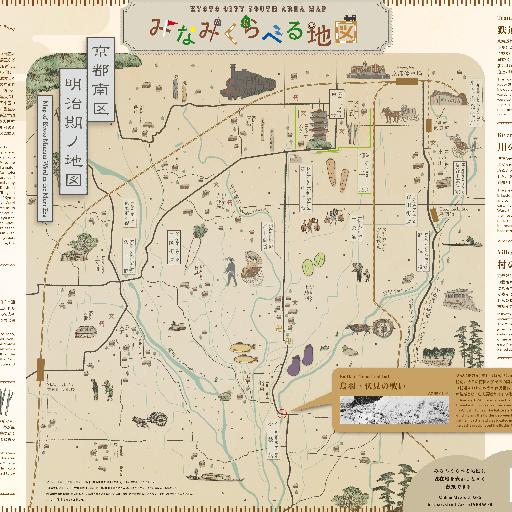All spots information
8 spots
 Point
Point

简体中文 English 日本語 1868(慶応4)年1月(新暦では同年2月)に起きた,旧幕府軍と薩摩・長州軍の間の戦闘。今日の南区と伏見区の間の鴨川にかかる小枝橋付近で始まりましたが,以後の戦場はおおむね今の伏見区内でした。薩長軍の勝利で終わりましたが,この戦いが発端となった戊辰戦争はその後も1年半近く続きました。 In January 1868 (February in the Gregorian calendar), a civil war called the Battle of Toba-Fushimi occurred between the former Tokugawa Shognate and the Satsuma-Choshu forces. The battle started near the Koedabashi Bridge over Kamogawa River which forms the border between the current Fushimi Ward and the Minami Ward, and the main battlefield was located in the Fushimi Ward. Satsuma-Choshu forces won, but the battle precipitated the Boshin War which lasted almost one and a half years. 于1868年1月(新历为同年2月)发生的旧幕府军与萨摩·长州军之间的战斗,是在现南区与伏见区之间往鸭川方面的小枝桥附近开始,但之后的战场大都是在现今的伏见区内。尽管以萨长军的胜利而告终,但以这场战斗为起因而引发的戊辰战争,在那之后又持续了近1年半。

简体中文 English 日本語 東海道線は1876(明治9)年に開通しました。ただし当初の駅(停車場)は京都と向日町だけで,西大路駅はありませんでした(1938(昭和13)年開業)。1895(明治28)年に奈良鉄道(後に国有化)と京都電気鉄道(後に京都市営)が開業しましたが,前者には現南区内に正式の駅はありませんでした。後者は竹田街道上の路面電車で,いくつかの停留所が設けられました。 The Tokaido Line opened in 1876 and at first there were only Kyoto Station and Mukomachi Station, with Nishioji Station starting operations in 1938. In 1895, Nara Railway (nationalized afterwards) and Kyoto Electric Railway (later operated by Kyoto City) were established, though there was no station of Nara Railway in the Minami Ward. On the other hand, Kyoto Electric Railway tram ran along Takedakaido Street, thus there were some stations in the Minami Ward. 东海道线是于1876年开通的。但当初的车站(停车地点)只有京都和向日町,没有西大路站(1938年开业)。于1895年,奈良铁路(后来国有化)开业,但在现南区内没有正式车站。同年,京都电气铁路(后来为京都市营)开业,在竹田街道上的有轨电车沿线,设立了几个电车站。

简体中文 English 日本語 京都から淀方面に向かうかつての主要道路で,現在の旧千本通に相当します。平安京ができた際に朱雀大路の延長線上に作られた鳥羽作道が起源です。長く本地域の主要交通路として人や物の移動に大きな役割を果たしましたが,明治時代の道幅は狭く,広い所でも4間(7メートル余)にすぎませんでした。 Tobakaido Street was the main road leading from Kyoto to Yodo, and it was located in the same location as the current Kyu-Senbon-dori Street. Tobakaido Street originates in Tobatsukurimichi Street, which was constructed to extend Suzaku-oji Street when the new capital Heiankyo was founded. Although the width of the road was rather narrow (approx.7 meters at most) for the Meiji Period, it played an important role in the transport of people and the distribution of goods. 这曾经是从京都前往淀方向的主要道路,相当于现在的旧千本路。在平安京兴建之时,在朱雀大路的延长线上修建了鸟羽作道,这就是它的起源。长期以来它作为该地区的主要交通路线,对人流和物流都起着很大作用。不过明治时代的路面狭窄,即使阔广的地方也只不过24尺(7米多)。

简体中文 English 日本語 葉の緑の部分が長く,全体として柔らかい特徴をもつネギです。江戸時代には現在の下京区南西部から南区にかけての一帯が主産地であったとされています。明治期には西九条,東九条などに生産の中心がありましたが,その後はしだいに上鳥羽などに移っていきました。 Kujo-negi are a type of green onions known for its long soft green stems. In the Edo Period, Kujo-negi were produced in the area covering the southeastern Shimogyo Ward and the entire Minami Ward. In the Meiji Period, the main producing areas were Nishikujo and Higashikujo, but afterwards have gradually changed to be near Kamitoba and other places. 九条葱是一种有着绿色部分很长的,整体脆软特征的葱条。在江户時代,其主要产地是从现在的下京区西南部至南区一带。在明治时期,西九条、东九条等地为生产中心,但之后逐渐移至上鸟羽等地。

简体中文 English 日本語 京都郊外の農村部では,古くから京都という大市場向けの野菜の栽培が盛んでした。現在の南区内も例外ではなく,明治期には九条ネギのほか,ダイコン,ニンジン,ナス,ウリなどの生産が盛んに行われていました。明治初期までは染料の原料となる葉藍の栽培も盛んでしたが,安価な輸入染料の普及により明治末期までに衰退しました。 In Kyoto’s suburban farming areas, agriculture has prospered since ancient times thanks to a large market for produce in Kyoto City. The Minami Ward has been no exception, and was the cultivation grounds for many varieties of vegetables, including Kujo-negi, daikon radishes, carrots, eggplants, cucumbers in the Meiji Period. Chinese indigo plants were also popularly cultivated until the early Meiji Period though the amount decreased in the late Meiji Period due to cheaper alternative dyes imported from overseas. 在京都郊外的农村,自古以来面向京都这个大市场,蔬菜的种植很旺盛。现在的南区也不例外,明治时期除了九条葱以外,亦盛产萝卜、胡萝卜、茄子、瓜类等。直至明治初期,栽培染料的原料叶蓝也很兴盛,但明治末期因为廉价进口染料的普及而衰落。

简体中文 English 日本語 「京都市」は1889(明治22)年に成立しましたが,現在の南区の範囲で当時から京都市に含まれていたのは,東寺とその周辺などごく一部に過ぎませんでした。その後,旧西九条村(1889年以後大内村大字西九条)が1902(明治35)年,東九条村の大部分,八条村,上鳥羽村の一部,旧唐橋村を含んで1889年に成立した七条村が1918(大正7)年,さらに上鳥羽村の残り(1889年までの旧塔森村を含む)と吉祥院村(1889年までの石島村,西中村を含む)が1931(昭和6)年にそれぞれ京都市下京区に編入されました。第二次大戦後の1955(昭和30)年になって,下京区のうち主に東海道本線以南の地区が分離し,南区が新たに誕生しました。ただし,南区北西部の下京区との境界線は東海道本線よりもかなり北に引かれています。なお,桂川西岸の久世村(1889年に上久世村,久世村,大藪村,築山村,東土川村の5旧村が合併して成立)は1959(昭和34)年に京都市南区に編入され,ここに今日に至る南区の区域が確定しました。 When Kyoto City was established in 1889, only a small portion of the current Minami Ward, such as the vicinity of Toji Temple, was included. In 1902, the city expanded adding the former Nishikujo Village (named Ouchi Village Oaza Nishikujo after 1889) to the Shimogyo Ward, and again in 1918 with the addition of a major part of Higashikujo Village, Hachijo Village, a portion of Kamitoba Village, Shichijo Village (which included the former Karahashi Village in 1889). In 1931 the rest of Kamitoba Village (including the area of the former Tonomori Village in 1889) and Kisshoin Village (including the Ishijima Village and Nishinaka Village in 1889) were also incorporated into the Shimogyo Ward of Kyoto City. Then in 1955 after the Second World War, Shimogyo Ward was divided into two sections. One of them, mainly the area south of the Tokaido Line, became the Minami Ward, though the actual border in the northwest section between the Shimogyo and Minami Ward is located further north of the Tokaido Line. Additionally, in 1959 Kuze Village located on the west banks of the Katsuragawa River (established in 1889 including Kamikuze Village, Kuze Village, Oyabu Village, Tsukiyama Village, Higashitsuchikawa Village) was added to Kyoto City, establishing the Minami Ward in its current form. “京都市” 成立于1889年,而现在的南区范围内属于当时京都市内的,只有东寺及其附近的一小部分。此后,旧西九条村(1889年以后大内村大字西九条)于1902年,七条村(七条村建立于1889年,包括了东九条村大部分、八条村、上鸟羽村一部分和旧唐桥村)于1918年,上鸟羽村的其余部分(包括至1889年的旧塔森村)和吉祥院村(包括至1889年的石岛村、西中村)于1931年,分别被编入到京都市下京区。到第二次世界大战后的1955年,下京区内主要由于东海道本线以南的地域分离出去,南区就重新诞生了。不过,南区西北部与下京区之间的边界线比东海道本线还要更加靠北。并且,于1959年桂川西岸的久世村(在1889年上久世村、久世村、大薮村、筑山村和东土川村的5个旧村合并成立)编入京都市南区,至今的南区区域就由此被确定了。

简体中文 English 日本語 現在の南区の範囲は,桂川,鴨川に加えて,いくつかの小河川も北から南に流れ,灌漑用水には恵まれていました。また南部の塔森地区では明治初期,アユなどの漁獲も重要な産業の一つでした。その一方で古くから水害も多く,明治期以後,水害への対策として河川改修もかなりの規模で行われました。 The area of the current Minami Ward is blessed with plenty of irrigation water thanks to the Katsuragawa River, Kamogawa River and some other small rivers running north to south. During the early Meiji Period in the Tonomori District in the south of Minami Ward, the fishing of sweetfish (ayu) and other varieties was one of the most important industries. In contrast floods have frequently occurred in this area since ancient times, and large-scale river improvement works to prevent floods and other strategies have been carried out since the Meiji Period. 现在的南区范围除桂川和鸭川外,还有几个小河川也从北往南流,从而获得了丰富的灌溉用水。此外明治初期在南部的塔森地区,香魚等的捕鱼业也是重要的产业之一。但另一方面,自古以来水灾也多,明治时期以后,作为防洪对策,还实施了相当大规模的河川改建。
